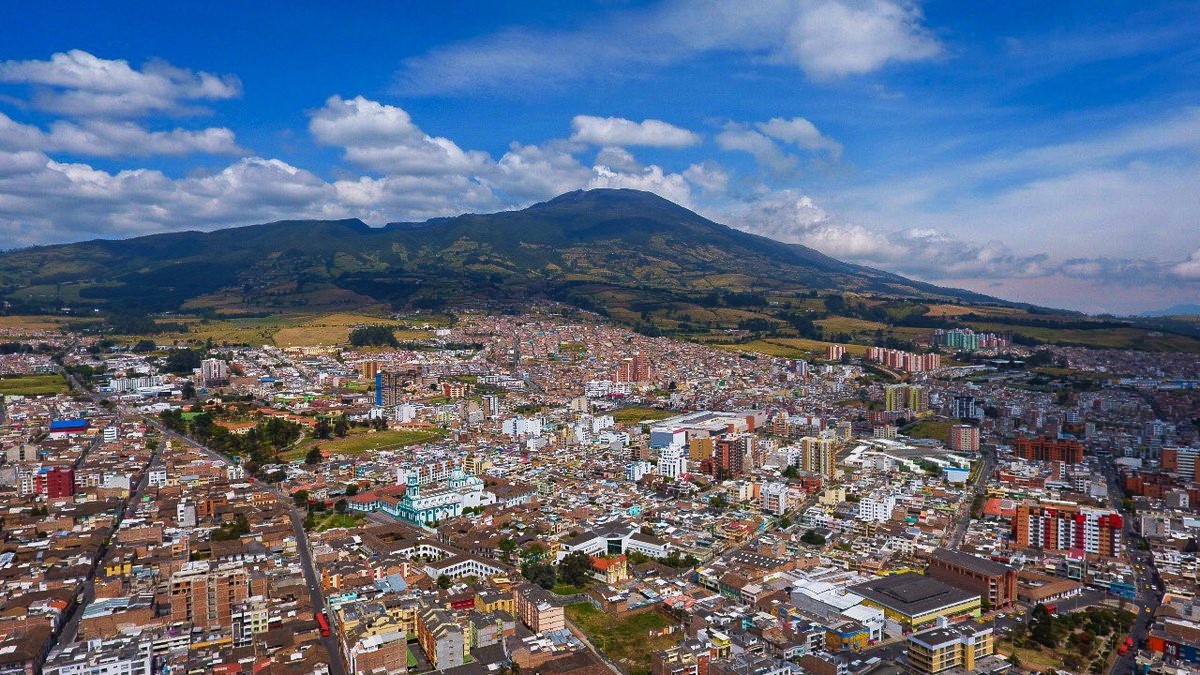
Nestled in the southwestern region of Colombia, Pasto is a city steeped in history, culture, and natural beauty. From its captivating landscapes to its rich heritage, Pasto offers a tapestry of experiences for visitors and locals alike. As we delve into the 33 fascinating facts about Pasto, you'll uncover the allure of this vibrant city, where tradition meets modernity and where the Andean spirit thrives. Let's embark on a journey through the streets of Pasto, where every corner reveals a new story, and every landmark whispers the secrets of the past. Join us as we uncover the essence of this enchanting city, from its iconic festivals to its breathtaking scenery, and from its culinary delights to its historical significance. Are you ready to explore the wonders of Pasto? Let's dive into the heart of this captivating Colombian gem and discover the 33 facts that make Pasto an extraordinary destination.
Key Takeaways:
- Pasto, a city in Colombia, offers a vibrant culture, stunning landscapes, and rich history. From its Black and White Carnival to its diverse cuisine, visitors can immerse themselves in the heart of the Andes.
- With its colorful murals, lively festivals, and diverse cuisine, Pasto invites travelers to experience the warmth and vibrancy of its community. The city’s rich heritage and breathtaking natural beauty make it a captivating destination.
Pasto is a city located in the Nariño Department, in the southwest of Colombia.
Nestled in the Andes Mountains, Pasto is known for its stunning landscapes and rich cultural heritage.
The city sits at an elevation of approximately 8,290 feet (2,527 meters) above sea level.
This high-altitude location contributes to the city's cool, temperate climate and breathtaking views of the surrounding mountains.
Pasto is home to the famous Black and White Carnival, one of the most significant cultural events in Colombia.
This vibrant festival, which takes place annually in early January, features lively parades, music, dance, and elaborate costumes, attracting visitors from around the world.
The city boasts a diverse culinary scene, offering a wide array of traditional Colombian dishes and local specialties.
From hearty stews to flavorful empanadas, Pasto's cuisine reflects a blend of indigenous, Spanish, and African influences.
Pasto is renowned for its unique architecture, characterized by colonial buildings and colorful, intricately designed facades.
Exploring the city's streets reveals a blend of historical and modern architectural styles, creating a visually captivating urban landscape.
The city is a hub of artistic and cultural expression, with numerous galleries, theaters, and performance spaces showcasing the talents of local and regional artists.
Visitors can immerse themselves in the vibrant arts scene, experiencing everything from traditional folk music to contemporary visual arts.
Pasto serves as a gateway to the stunning natural beauty of the surrounding region, including lakes, volcanoes, and national parks.
Outdoor enthusiasts can partake in activities such as hiking, birdwatching, and exploring the unique páramo ecosystems that characterize the Andean highlands.
The city's economy is driven by agriculture, particularly the production of dairy products, coffee, and sugarcane.
The fertile lands surrounding Pasto support a thriving agricultural sector, with dairy farming playing a significant role in the local economy.
Pasto is home to several institutions of higher education, contributing to its reputation as an intellectual and cultural center in the region.
The presence of universities and research centers fosters a dynamic academic environment and attracts students from across Colombia and beyond.
The city's transportation infrastructure includes an extensive network of roads, as well as an airport providing connections to major cities in Colombia.
This accessibility facilitates both domestic and international travel, supporting tourism and trade in the region.
Pasto's history is rich and storied, with indigenous peoples, Spanish conquistadors, and African descendants all contributing to its cultural tapestry.
The city's historical sites and museums offer a window into its past, allowing visitors to delve into its fascinating heritage.
The surrounding region is known for its traditional crafts, including intricate weaving, pottery, and woodwork.
Artisans in the area produce a variety of handmade goods, showcasing the region's artistic traditions and craftsmanship.
The city's religious architecture is notable, with several churches and cathedrals featuring stunning design and historical significance.
These religious landmarks are not only places of worship but also architectural marvels that reflect the city's spiritual and cultural heritage.
Pasto's music scene is vibrant and diverse, encompassing genres such as Andean music, salsa, and contemporary Colombian pop.
Live performances and music festivals provide opportunities to experience the rhythms and melodies that form an integral part of the city's cultural identity.
The city's bustling markets offer a wide range of goods, from fresh produce and artisanal crafts to clothing and household items.
Exploring the local markets provides a glimpse into daily life in Pasto and an opportunity to discover unique souvenirs.
Pasto's natural surroundings provide a habitat for diverse flora and fauna, making it a haven for nature enthusiasts and ecotourism.
The region's biodiversity and ecological significance contribute to its appeal as a destination for sustainable and responsible travel.
The city's vibrant nightlife scene includes bars, clubs, and entertainment venues where locals and visitors come together to socialize and celebrate.
From cozy cafes to energetic dance floors, Pasto offers a lively and welcoming atmosphere for nighttime entertainment.
Pasto's cultural traditions are deeply rooted in indigenous customs and rituals, which are celebrated and preserved through festivals and community events.
These traditions serve as a testament to the city's rich heritage and the resilience of its indigenous communities.
The city's annual patron saint festivities honor San Juan de Pasto, featuring religious processions, traditional music, and culinary delights.
This important celebration brings together residents and visitors to pay homage to the city's patron saint and participate in time-honored rituals.
Pasto's location near the equator results in relatively consistent day length throughout the year, with sunrise and sunset times varying by only a few hours.
This unique geographical feature contributes to the city's pleasant climate and the natural rhythms of life in the region.
The city's streets are adorned with vibrant murals and street art, showcasing local artists' creativity and contributing to the city's colorful ambiance.
These artistic expressions add a layer of visual interest to the urban landscape, inviting exploration and appreciation.
Pasto's proximity to volcanic landscapes, including the Galeras Volcano, offers opportunities for geological exploration and scientific study.
The region's volcanic activity has shaped its terrain and provides insight into the Earth's natural processes.
The city's cultural institutions, such as museums and cultural centers, play a vital role in preserving and promoting the region's heritage and artistic legacy.
These institutions serve as guardians of the city's cultural identity, offering educational resources and immersive experiences for visitors.
Pasto's traditional cuisine features local ingredients such as potatoes, corn, and Andean grains, reflecting the region's agricultural abundance.
Dishes like cuy asado (roast guinea pig) and mote pillo (hominy and eggs) showcase the culinary traditions of the Andean highlands.
The city's public parks and green spaces provide residents and visitors with areas for relaxation, recreation, and outdoor gatherings.
These urban oases offer a respite from the bustling city streets and contribute to the overall quality of life in Pasto.
Pasto's architecture reflects a blend of indigenous, Spanish colonial, and contemporary styles, creating a visually captivating urban landscape.
The city's buildings and monuments tell the story of its evolution over time, from pre-Columbian influences to modern-day design trends.
The city's proximity to diverse ecosystems, including cloud forests and páramo, makes it an ideal destination for eco-tourism and nature enthusiasts.
Exploring the region's natural wonders offers opportunities for adventure and environmental appreciation.
Pasto's cultural diversity is evident in its festivals, music, and culinary traditions, which are influenced by the indigenous, Spanish, and African heritage of the region.
This cultural fusion creates a vibrant tapestry of traditions and customs that define the city's identity.
The city's strategic location as a crossroads of Andean cultures and ecosystems contributes to its significance as a cultural and geographical hub.
Pasto serves as a gateway to the diverse landscapes and cultural expressions found throughout the Andean region.
Pasto's vibrant arts scene encompasses a wide range of disciplines, including visual arts, music, theater, and literature, fostering creativity and cultural exchange.
Artists and performers in the city contribute to a dynamic and evolving cultural landscape, enriching the lives of residents and visitors alike.
The city's Black and White Carnival, with its elaborate costumes, music, and dance, showcases the creativity and spirit of the local community.
This iconic festival is a testament to the city's cultural vitality and its ability to bring people together in celebration.
Pasto's rich history and cultural heritage are preserved and celebrated through museums, historical sites, and community initiatives that highlight the city's legacy.
These efforts ensure that the stories and traditions of Pasto continue to resonate with present and future generations.
The city's culinary scene reflects a fusion of traditional Andean ingredients and flavors, offering a diverse array of dishes that celebrate the region's agricultural bounty.
From hearty soups to savory meat dishes, Pasto's cuisine is a testament to the culinary traditions of the Andean highlands.
Pasto, a city nestled in the Andes Mountains of Colombia, captivates visitors with its rich cultural heritage, stunning landscapes, and vibrant community. At an elevation of approximately 8,290 feet (2,527 meters) above sea level, the city enjoys a cool, temperate climate and serves as the host of the renowned Black and White Carnival, a colorful celebration of local culture and creativity. Pasto's culinary scene showcases a diverse array of traditional Colombian dishes, while its unique architecture and bustling arts scene reflect the city's dynamic cultural identity. As a gateway to the natural beauty of the surrounding region, including lakes, volcanoes, and national parks, Pasto offers opportunities for outdoor exploration and ecotourism. With a rich history shaped by indigenous, Spanish, and African influences, the city's museums and historical sites provide insight into its storied past. From its vibrant music scene to its bustling markets and vibrant nightlife, Pasto invites visitors to immerse themselves in its lively atmosphere and welcoming community.
The city's cultural traditions, deeply rooted in indigenous customs and rituals, are celebrated through festivals and community events, preserving its rich heritage and the resilience of its indigenous communities. Pasto's annual patron saint festivities honor San Juan de Pasto, featuring religious processions, traditional music, and culinary delights, bringing together residents and visitors in homage to the city's patron saint. The city's streets are adorned with vibrant murals and street art, showcasing local artists' creativity and contributing to the city's colorful ambiance. Pasto's proximity to volcanic landscapes offers opportunities for geological exploration and scientific study, providing insight into the Earth's natural processes. The city's cultural institutions, such as museums and cultural centers, play a vital role in preserving and promoting the region's heritage and artistic legacy, offering educational resources and immersive experiences for visitors.
Pasto's traditional cuisine features local ingredients such as potatoes, corn, and Andean grains, reflecting the region's agricultural abundance. Dishes like cuy asado (roast guinea pig) and mote pillo (hominy and eggs) showcase the culinary traditions of the Andean highlands. The city's public parks and green spaces provide residents and visitors with areas for relaxation, recreation, and outdoor gatherings, contributing to the overall quality of life in Pasto. Pasto's architecture reflects a blend of indigenous, Spanish colonial, and contemporary styles, creating a visually captivating urban landscape that tells the story of its evolution over time. The city's proximity to diverse ecosystems, including cloud forests and páramo, makes it an ideal destination for eco-tourism and nature enthusiasts, offering opportunities for adventure and environmental appreciation. Pasto's cultural diversity is evident in its festivals, music, and culinary traditions, which are influenced by the indigenous, Spanish, and African heritage of the region, creating a vibrant tapestry of traditions and customs that define the city's identity.
The city's vibrant arts scene encompasses a wide range of disciplines, including visual arts, music, theater, and literature, fostering creativity and cultural exchange. Artists and performers in the city contribute to a dynamic and evolving cultural landscape, enriching the lives of residents and visitors alike. The city's Black and White Carnival, with its elaborate costumes, music, and dance, showcases the creativity and spirit of the local community, serving as a testament to the city's cultural vitality and its ability to bring people together in celebration. Pasto's rich history and cultural heritage are preserved and celebrated through museums, historical sites, and community initiatives that highlight the city's legacy, ensuring that the stories and traditions of Pasto continue to resonate with present and future generations. The city's culinary scene reflects a fusion of traditional Andean ingredients and flavors, offering a diverse array of dishes that celebrate the region's agricultural bounty, from hearty soups to savory meat dishes, Pasto's cuisine is a testament to the culinary traditions of the Andean highlands.
In conclusion, Pasto's vibrant culture, breathtaking landscapes, and rich history make it a captivating destination for travelers seeking an immersive experience in the heart of the Colombian Andes. Whether exploring the city's architectural treasures, savoring its traditional cuisine, or participating in its lively festivals, visitors are sure to be enchanted by the warmth and vibrancy of Pasto's community.
Conclusion
In conclusion, Pasto is a city rich in history, culture, and natural beauty. From its fascinating colonial architecture to the breathtaking landscapes that surround it, Pasto offers a unique experience for visitors. The city's vibrant arts scene, traditional festivals, and warm hospitality make it a must-visit destination for those seeking an authentic Colombian experience. With its diverse array of attractions, including the stunning Laguna de la Cocha and the mysterious San Juan de Pasto Cathedral, there's no shortage of wonders to explore in this enchanting city. Whether you're a history buff, nature enthusiast, or simply looking to immerse yourself in a new and captivating culture, Pasto has something special to offer.
FAQs
What are the must-visit attractions in Pasto?The must-visit attractions in Pasto include the San Juan de Pasto Cathedral, the Taminango Museum, the Laguna de la Cocha, and the La Cocha Nature Reserve. Each of these sites offers a unique glimpse into the history, culture, and natural beauty of the region.
What is the best time of year to visit Pasto?The best time to visit Pasto is during the city's renowned Carnival of Blacks and Whites, typically held in early January. This vibrant and colorful festival is a celebration of cultural diversity and is a truly unforgettable experience for visitors. Additionally, the months of June to August offer pleasant weather and are ideal for exploring the city and its surrounding attractions.
Pasto's rich tapestry of history, culture, and natural wonders captivates visitors from around the world. This vibrant Colombian city offers a gateway to unforgettable experiences, from its colorful festivals and mouthwatering cuisine to its stunning architecture and breathtaking landscapes. As you explore the depths of Pasto's fascinating facts, consider delving into the world of sports with our article on Deportivo Pasto Football Club. Uncover the passion and pride that fuels this beloved team and its dedicated fans.
Was this page helpful?
Our commitment to delivering trustworthy and engaging content is at the heart of what we do. Each fact on our site is contributed by real users like you, bringing a wealth of diverse insights and information. To ensure the highest standards of accuracy and reliability, our dedicated editors meticulously review each submission. This process guarantees that the facts we share are not only fascinating but also credible. Trust in our commitment to quality and authenticity as you explore and learn with us.


